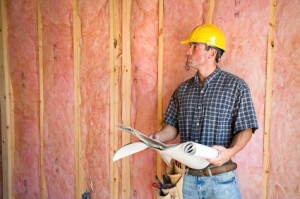 Insulation acts like an enormous blanket wrapped around your home, slowing heat in its race to escape to the cold outdoors in winter and keeping the heat out in summer.
Insulation acts like an enormous blanket wrapped around your home, slowing heat in its race to escape to the cold outdoors in winter and keeping the heat out in summer.
NOTE: This topic goes hand-in-hand with Air sealing. Without a good air and vapour barrier, your insulation will not be effective.
Insulation is manufactured and sold with a thermal resistance value (RSI value), which measures resistance to heat flow. The higher the value the better. (R-value is the imperial version of the RSI value.) For insulation to meet its RSI value, it must be installed properly and have a good vapour barrier. (1)
New homes
The best advice for people buying or building a new home is to make sure the house meets R-2000 or Passive House standards.
R-2000 homes will have insulation values above local building codes. In fact, requirements for the whole package of energy efficiency requirements will be about 40% above building codes, resulting in 30% less energy use than conventional new homes. (2)
There are many varieties of insulation to choose from. Each has its advantages and disadvantages. But if reducing greenhouse gas emissions is one of your main concerns, research how the insulation is manufactured as there may be indirect climate costs associated with your choice. For instance, some insulation is highly energy intensive (fibreglass) or is made from petrochemicals (Polystyrene products). (3)
Existing Homes
How to retrofit an existing home with insulation will depend greatly on the era of the home.
- In Manitoba, homes built around 1900 often had wood shaving insulation.
- Those built in following decades had no insulation.
- Around the 1930s wood shavings and fibreglass or rockwool batting became common.
- If there’s no insulation in place, it’s relatively easy to drill holes and blow in cellulose insulation.
- Wood shavings may have settled and need to be vacuumed out first.
- Walls with batting will prove the most challenging, as interior walls will need to be opened for it to be removed. (4)
How much insulation and what type of insulation depends on local housing codes, the way the house is built, what other work is being done on the house, and the location for the insulation.
Here are some general pointers:
- Attic – If there’s less than 6 inches of insulation in the attic, it will be worth putting more in.
- Frame – Walls account for 10-30% of the heat loss in houses, stemming from poor insulation as well as air leakage through cracks. If there’s no insulation in the walls, it’s worth blowing some in.
- Basement – Basements are an often unexpected source of heat loss in a home – up to 20-35% of the total – either through the large uninsulated surface above and below grade levels, or through air leakage. Combining insulation with damp proofing on the exterior or finishing the interior will garner double the benefits. (5)




